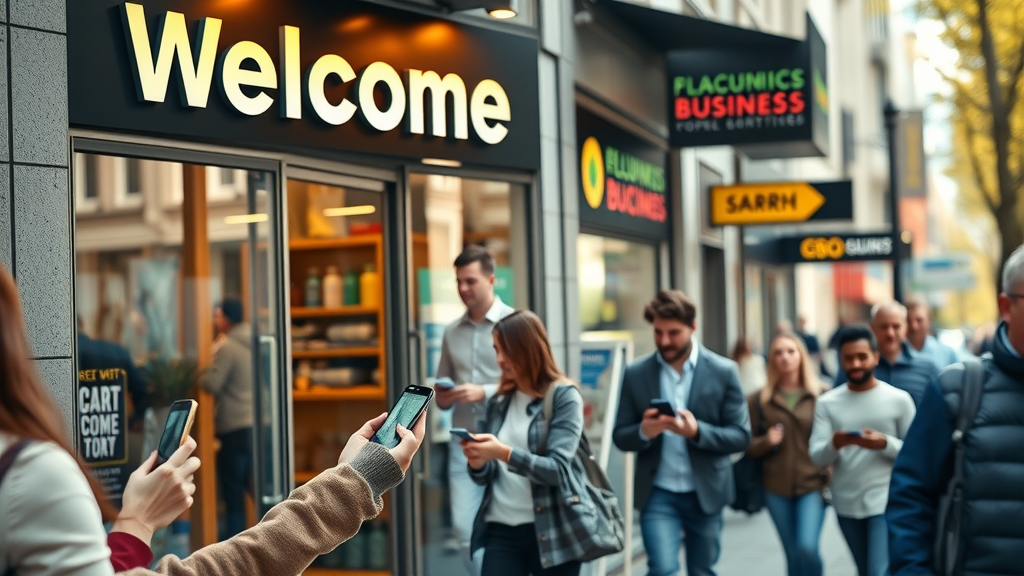Did you know that over 60% of all local searches are made from mobile devices? If your business isn’t prioritizing mobile local SEO , you’re missing out on a massive—and rapidly growing—segment of customers who are ready to visit or call your local business right now. This guide reveals proven strategies to ensure your local business rises above the competition in mobile search results, draws more nearby traffic, and converts mobile users into lifelong customers.
Unlocking Mobile Local SEO: What You Need to Succeed
- Explore what you’ll learn in this guide to mobile local SEO, from mobile optimization basics to advanced tactics for local business growth and increased visibility in mobile search results.
Why Mobile Local SEO Is Non-Negotiable for Local Businesses
- A recent study revealed over 60% of local searches occur on mobile devices—making mobile local SEO crucial for staying competitive. Discover why optimizing for mobile search is no longer optional if you want to reach nearby customers.
The shift to mobile devices is reshaping the local search landscape in unprecedented ways. Nearly every potential customer has a smartphone or tablet within reach and uses these devices for instant, location-based searches. As convenience becomes a top priority, businesses that prioritize mobile local SEO capitalize on more moments when customers are searching for solutions nearby. Ignoring this trend means leaving money—and visibility—on the table, as your competitors appear in those critical micro-moments while your business remains invisible.
For local businesses , the opportunity isn’t just about being found online. Mobile SEO connects you with a motivated mobile user at the very moment they’re ready to make a decision. Whether it’s a phone call, a store visit, or a digital order, optimizing your site for mobile ensures you capture these high-intent interactions and drive meaningful growth for your bottom line.

Unlocking Mobile Local SEO: What You Need to Succeed
- Explore what you’ll learn in this guide to mobile local SEO , from mobile optimization basics to advanced tactics for business growth and increased visibility in local mobile search results.
In our comprehensive breakdown, you’ll gain actionable insights on responsive design, mobile site speed, Google Business Profile optimization, local SEO signals, and using structured data to stand out in mobile search results. You’ll also learn next-gen tactics including voice search strategies, user engagement best practices, and tools for lasting mobile local SEO results.
By mastering these core strategies, your local business can attract mobile users actively searching for vendors, services, or experiences right in their area. Prepare to transform your mobile presence, outperform your competitors, and claim top spots in local search—where the customer journey most often begins.
Understanding the Mobile Local SEO Landscape
The Growth of Mobile Devices in Local Search
The prevalence of mobile devices has forever changed how consumers interact with local businesses. According to market research, more than half of all local searches occur via smartphones and tablets—a clear indication that consumers expect seamless, fast, and relevant experiences on the go. These changes aren’t just generational; even older demographics now rely on mobile search to find nearby restaurants, service providers, or stores, further underlining the critical role mobile local SEO plays for every business.
For local business owners, adapting to these shifts means embracing not only a mobile-friendly website but also features like click-to-call, location maps, and accessible business information. As more users use voice search or geo-targeted mobile queries, businesses must optimize their digital presence to capture foot traffic and spontaneous purchases that start with a mobile device tap.

How Mobile SEO Differs from Traditional SEO
Mobile SEO focuses on delivering the best possible experience to users searching from smartphones or tablets. Unlike traditional desktop search engine optimization, mobile-centric approaches require lightning-fast loading speeds, clickable phone numbers, and layouts that adapt beautifully to smaller screens. Responsive design and site navigation play a pivotal role, ensuring the user experience remains intuitive and frustration-free.
Moreover, mobile users tend to act with greater urgency—a person searching “best pizza near me” from their phone is probably minutes away from making a dining decision. As such, mobile local SEO strategies must prioritize local intent, display vital business details prominently, and enable instant engagement (such as calls or directions) to edge out competitors in local search results.
A Comparison Table: Desktop vs. Mobile SEO for Local Businesses
| SEO Factors | Desktop Local SEO | Mobile Local SEO |
|---|---|---|
| Loading Speed | Important | Critical |
| Google Business Profile Optimization | Useful | Essential |
| Responsive Design | Good Practice | Mandatory |
| Click-to-Call | Less Relevant | Highly Relevant |
| Voice Search | Limited | Increasingly Common |
| Bounce Rate Impact | Moderate | High |
Core Tactics for Optimizing Local Search on Mobile Devices
Responsive Design: Building a Seamless Mobile Experience
A responsive design ensures your website automatically adjusts to fit any mobile device, offering a consistent user experience across smartphones, tablets, and desktops. This adaptability is no longer just nice to have—it’s an essential component of effective mobile local SEO . Google and other search engines favor mobile-friendly websites, considering not just the speed of loading but also the effortless navigation and usability users expect.
Without a responsive site for mobile , your local business risks high bounce rates and lost opportunities. Features like touch-friendly buttons, scalable images, and streamlined content layouts maintain engagement. Prioritize clarity, clean design, and intuitive pathways from search result to conversion to retain mobile users and secure more local traffic.

Mobile Optimization: Speed, Usability, and Site for Mobile
Mobile optimization is the cornerstone of successful mobile local SEO . Since mobile users demand quick, frictionless experiences, your site must load in under three seconds and offer instant usability. Use tools like Pagespeed Insights for data-driven enhancements such as image compression, script reduction, and server optimizations. These efforts keep impatient mobile users from bouncing back to the search engine results page.
In addition, test every aspect of your website for mobile , including graphics, interactive forms, and mobile navigation. Aim for single-column layouts, readable text without zooming, and effortless swiping or tapping to ensure your site is truly optimized for mobile . These features bolster trust, boost conversion rates, and signal to search engines that your local business values the mobile user .
Google Business Profile and Local Listings for Mobile Local SEO
Your Google Business Profile (formerly Google My Business) is a powerful tool for improving visibility in local search —especially when optimized for mobile. Mobile users frequently use Google Maps or Search to find local services, read reviews, or contact businesses with a single tap. Ensure your NAP (Name, Address, Phone Number) is accurate and consistent, upload professional photos, regularly update your hours, and enable messaging to make the most of your business listing.
A well-optimized business profile not only attracts more views in local search results but also increases interactions from mobile users—driving calls, in-store visits, or online orders. Monitor and respond to reviews promptly, post timely updates, and use local keywords relevant to your business in descriptions and posts.
“Optimizing your business profile for mobile local SEO is not just about being found—it’s about being chosen.”
Enhancing Mobile SEO: Key Tips for Local Businesses
Local SEO Signals: NAP Consistency, Reviews, and Citations
For strong local SEO on mobile, it’s vital to keep your NAP info consistent across all platforms, from your Google Business Profile to directories and social media. Inconsistencies can confuse search engines and hurt your search ranking. Encourage positive reviews and quickly resolve negative feedback; these ratings enhance your reputation and attract more mobile users.
Citations —mentions of your business name, address, and phone number on reputable third-party sites—act as validation for search engines. The more accurate and widespread your citations, the higher your trust signals for Google and improved local ranking. Always audit and update your listings periodically.

Mobile Search Engine Optimization: Schema Markup & Structured Data
Adding schema markup to your site’s code helps search engines better understand your business’s offerings, location, and events. With structured data, your local business can appear in rich results—such as featured snippets, review stars, or maps—with prominent details readily accessible on mobile device screens.
Prioritize local business, review, and event schema to deliver the info mobile users want most. Thorough mobile engine optimization with structured data gives your business a competitive edge in crowded local search result pages, driving higher engagement and more foot traffic.

Voice Search and Local Search Engine Trends on Mobile Devices
The rise of voice assistants like Siri, Google Assistant, and Alexa means more local searches are made by spoken query. People often use conversational keywords and specific questions (“Where’s the nearest dry cleaner open now?”). Businesses must tailor content and local SEO optimization to address these natural language queries for mobile searchers.
To stay ahead, update your content to answer FAQ-style and long-tail questions, use structured data, and monitor evolving search engine trends. As voice-driven mobile local SEO matures, you’ll capture traffic from customers who want quick, hands-free results.
User Experience and Engagement in Mobile Local SEO
Optimizing for User Experience: Navigation and Interactivity
An intuitive user experience on mobile devices is paramount for local businesses aiming to convert fleeting attention into meaningful action. Prioritize clear, simple navigation menus, visible contact options, and interactive elements (like maps and instant messaging) tailored for thumb-friendly tapping. Structure your website for mobile so customers find what they need in seconds.
Mobile users expect speed, ease, and engagement—features that foster positive impressions and prompt conversions. As you optimize your mobile site , conduct regular usability tests across devices to identify (and correct) frustrating navigation points, ensuring every mobile user leaves with a smile and a reason to return.

Reducing Bounce Rate with Mobile-Friendly Elements
A high bounce rate on mobile is a clear sign your site isn’t meeting user expectations. Combat this by ensuring all visual and interactive elements load quickly, call-to-action (CTA) buttons are prominent and easy to tap, and essential information is “above the fold” (visible without scrolling). Use contrasting colors for key actions and maintain a clutter-free mobile environment.
Additionally, optimize for local intent: pre-fill contact forms, auto-load maps, and show user reviews up front. These enhancements streamline the mobile journey, decrease frustration, and encourage visitors to move deeper into your site for mobile rather than bouncing back to the search results.
Calls-to-Action: Click-to-Call and Mobile Conversions
Strong CTAs, particularly click-to-call buttons, are a cornerstone of mobile local SEO for local businesses . Many mobile users searching local keywords are ready to act—often preferring to call rather than fill out web forms. Strategically place CTAs in headers, footers, and near business information to maximize conversion opportunities.
Adding instant messaging or booking tools alongside your phone number further accelerates the decision-making process. Make every conversion pathway obvious and easy to access, so users move from intent to action—generating immediate and measurable growth.

Top 10 Features Every Mobile Site for Local SEO Should Have
- Responsive design for seamless device scaling
- Fast loading speeds (under 3 seconds)
- Prominent click-to-call and contact buttons
- Easy-to-use navigation menus
- Local NAP (Name, Address, Phone) details on every page
- Integrated Google Maps location
- Visible, up-to-date business hours
- On-page reviews/testimonials
- Simplified lead forms or booking tools
- Contextual content relevant to local search intent
Content and Local Search: Creating Relevant, Geo-Optimized Content for Mobile
Writing for Mobile Local Searches: Best Practices for Content
Mobile users have unique expectations—brevity, relevance, and local specificity are key. Structure your content with short paragraphs, bulleted lists, and clear headlines to make scanning easy. Focus on targeted local search phrases, such as “coffee shop near Lincoln Park,” and weave them naturally into your web copy, FAQs, and blog posts.
Anticipate the “micro-moments” of your customer’s journey and address them directly with city, neighborhood, or popular attraction names. By aligning your writing style with mobile search behavior, your local business remains visible and attractive in search engine results—on any device.
Using Mobile Device Data for Localized Content Strategy
Harness mobile analytics and device data to personalize your content even further. Analyze where your mobile users are coming from, which keywords drive traffic, and what pages have the highest engagement. Geo-targeted promotions, city-specific service pages, and localized event announcements can help tailor your approach for each audience segment.
Regularly review data to spot emerging trends, such as popular queries from new neighborhoods or spikes in mobile use at certain times. Adapt your content and ad strategies to stay ahead in mobile local SEO and consistently drive more local traffic.

Watch short explainer videos about best practices for blending voice search and mobile local SEO. Visual content quickly demonstrates how to structure local keywords, use conversational phrases, and enhance your Google Business Profile—all crucial for reaching mobile searchers.
Google Business Profile and Advanced Mobile Local SEO
Setting Up and Optimizing Google Business Profile for Mobile Local SEO
Claim, verify, and optimize your Google Business Profile with accurate information, high-quality images, and targeted local keywords. For mobile users, features like instant directions, click-to-call, and review responses can be the deciding factor between your business and a competitor.
Regular updates—such as holiday hours, special offers, and new photos—signal an active, trustworthy business to both search engines and customers. Use Google’s Q&A and messaging features to engage directly with mobile users researching on-the-go.

Leveraging Business Profile Posts and Messaging for Mobile Engagement
Take advantage of Google Business Profile’s Post and Messaging features to broadcast timely offers or updates directly to nearby mobile users. Sharing events, limited-time promotions, or new service announcements helps attract foot traffic and create urgency among local audiences searching on their mobile device.
Activating messaging empowers potential customers to instantly connect for inquiries, reservations, or support—offering another channel for conversion and customer satisfaction.
Key Takeaways: Maximizing Visibility in Mobile Local Searches
- Keep Google Business Profile accurate and engaging
- Optimize for speed and mobile user experience
- Encourage and respond to reviews
- Implement schema and structured data
- Provide mobile-specific conversion options (click-to-call, text, booking)
Technical SEO for Mobile Local SEO Success
Using Pagespeed Insights and Speed Insights for Mobile Optimization
Technical mobile SEO starts with measuring and improving speed. Pagespeed Insights lets you analyze load times, identify bottlenecks, and prioritize fixes for mobile-specific issues. Address image compression, script minification, and server caching to shave valuable seconds off your load time.
Frequent audits using Speed Insights can help you catch emerging slowdowns caused by code changes or new content, ensuring your site for mobile remains fast and competitive in search results.

Mobile Schema and Structured Data for Local SEO
Incorporate structured data with schema.org tags—especially LocalBusiness, Review, and Event schemas—to help search engines display your business information in rich snippets. Structured data improves the way Google represents your business on mobile SERPs, making ratings, hours, and locations more prominent and clickable.
Continually refine your structured data based on Google’s guidelines for mobile search, as these algorithms evolve to prioritize trustworthy, content-rich local businesses.
Monitoring and Fixing Mobile SEO Errors for Local Businesses
Use tools like Google Search Console to regularly scan for mobile usability issues such as broken links, unreadable text, overlapping elements, or faulty redirects. Immediate error resolution maintains a seamless mobile experience that search engines reward with higher rankings in local results.
Don’t overlook the mobile-specific index in your site audits. Correcting errors related to mobile loading, structured data, or indexing ensures your business remains among the top local listings on mobile devices.
Must-Have Tools for Effective Mobile Local SEO
- Pagespeed Insights
- Google Search Console
- BrightLocal
- Moz Local
- SEMrush Mobile Tools
- Google My Business App
- Schema Markup Generators
- Hotjar (Mobile User Insights)
- Answer The Public (for local queries)
- Mobile-Friendly Test by Google
FAQ About Mobile Local SEO for Local Businesses
Can I do SEO from mobile?
- Yes, with multiple digital tools and mobile-optimized platforms, most SEO tasks, such as updating content, tracking rankings, and managing local profiles, can be completed from mobile devices. However, complex audits and in-depth analyses may still require desktop access.
Are 46% of Google searches local?
- Yes, according to recent research, 46% of every Google search is local, highlighting the significant opportunity for businesses focusing on mobile local SEO to capture nearby customers actively searching from their mobile devices.
Is mobile SEO different from desktop SEO?
- Absolutely—mobile SEO focuses intensely on user experience, fast loading times, responsive design, click-to-call features, and prioritizes local search intent, all of which differ from traditional desktop SEO approaches.
How does mobile search influence local SEO?
- Mobile search amplifies the immediacy and intent behind local queries—users searching from mobile devices are more likely to act quickly, visit physical locations, or call businesses compared to desktop users.
Real-World Examples: Local Business Success Stories Using Mobile Local SEO
Case Study: A Local Restaurant Boosts Traffic with Mobile Optimization
After implementing a mobile-first redesign and optimizing its Google Business Profile , a local Italian restaurant noticed a 45% increase in table reservations originating from mobile search. High-quality food photos, click-to-call buttons, and visible customer reviews fostered trust and prompted visitors to quickly make reservations or order online—proving mobile local SEO transforms casual searchers into loyal patrons.

Interview Quote: Expert Tips on Local Search from a Leading SEO Strategist
“Local businesses willing to invest in mobile local SEO always see the quickest returns on foot traffic and customer engagement.” — Jamie Penn, SEO Consultant
Explore inspiring video case studies where small local businesses achieve double-digit growth in in-store visits, phone inquiries, and positive reviews—all driven by strategic mobile local SEO improvements.
Future-Proofing Your Mobile Local SEO Strategy
Emerging Trends in Mobile Local Search
From AI-powered assistants to augmented reality overlays on mobile maps, mobile local SEO continues to evolve. Marketers are already embracing “hyperlocal” geotargeting, visual search, shoppable image galleries, and zero-click mobile search results. These innovations heighten user convenience and drive spontaneous, in-the-moment actions, opening new competitive advantages for agile local businesses.

Anticipating Changes in Search Engine Algorithms
Search engines continuously refine algorithms, increasingly prioritizing speed, structured data, context-driven results, and mobile-first indexing. Stay prepared by updating your mobile site regularly, maintaining robust structured data, and following Google’s official recommendations for mobile usability. Being proactive prevents costly dips in mobile search visibility.
Keep up with SEO news, participate in industry webinars, and test different on-site elements on a regular basis to ensure your mobile local SEO strategy withstands algorithm changes and always serves the needs of local searchers.
Next-Gen Tactics for Continued Mobile Local SEO Success
- Integrate AI chatbots for instant mobile customer support
- Use AR to highlight in-store promotions via mobile apps
- Optimize for “zero-click” results (info visible without visiting your site)
- Launch mobile wallet and contactless payment features
- Expand to voice commerce with smart assistant integration
- Diversify content formats (short-form video, stories, local influencer content)
Key Insights and Recap for Mobile Local SEO
- Mobile local SEO drives more local business than ever before; focus on speed, user experience, and local content to stay ahead. Consistent Google Business Profile updates, reviews, and schema matter more than ever.
Take Action and Accelerate Growth with Mobile Local SEO
- Ready to attract more local customers via mobile local SEO? Start optimizing your site for mobile, enhance your business profile, and take charge of your mobile local search presence today.
Start by assessing your mobile user experience, prioritize speed and visibility, and strengthen your Google Business Profile. Engage consistently—and watch your local business win more customers from every mobile search.
Sources
- Moz – https://moz.com/blog/local-seo-mobile-search
- BrightLocal – https://www.brightlocal.com/research/local-consumer-review-survey/
- Google Search Central – https://developers.google.com/search/mobile-sites/
- Search Engine Land – https://searchengineland.com/the-evolution-of-local-seo-and-where-its-going-next-272689
- Search Engine Journal – https://www.searchenginejournal.com/mobile-local-seo-guide/
To enhance your understanding of mobile local SEO, consider exploring the following resources:
-
“Mobile SEO: The Ultimate Guide” ( yoast.com )
-
“Mobile Optimization for Local SEO Growth” ( bpcustomdev.com )
These articles provide comprehensive insights into optimizing your website for mobile users, ensuring your business effectively reaches local customers searching on-the-go.
 Add Row
Add Row  Add
Add 










Write A Comment